| Listing 1 - 10 of 22 | << page >> |
Sort by
|
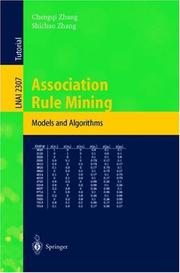
ISBN: 3540435336 3540460276 Year: 2002 Publisher: Berlin, Heidelberg : Springer Berlin Heidelberg : Imprint: Springer,
Abstract | Keywords | Export | Availability | Bookmark
 Loading...
Loading...Choose an application
- Reference Manager
- EndNote
- RefWorks (Direct export to RefWorks)
Due to the popularity of knowledge discovery and data mining, in practice as well as among academic and corporate R&D professionals, association rule mining is receiving increasing attention. The authors present the recent progress achieved in mining quantitative association rules, causal rules, exceptional rules, negative association rules, association rules in multi-databases, and association rules in small databases. This book is written for researchers, professionals, and students working in the fields of data mining, data analysis, machine learning, knowledge discovery in databases, and anyone who is interested in association rule mining.
Association rule mining. --- Computer algorithms. --- Association mining --- Association rules mining --- Mining, Association rule --- Computer science. --- Algorithms. --- Database management. --- Information storage and retrieval. --- Artificial intelligence. --- Computer Science. --- Artificial Intelligence (incl. Robotics). --- Database Management. --- Information Storage and Retrieval. --- Algorithm Analysis and Problem Complexity. --- Algorithms --- Data mining --- Information storage and retrieva. --- Computer software. --- Artificial Intelligence. --- Information storage and retrieval systems. --- Software, Computer --- Computer systems --- Data base management --- Data services (Database management) --- Database management services --- DBMS (Computer science) --- Generalized data management systems --- Services, Database management --- Systems, Database management --- Systems, Generalized database management --- Electronic data processing --- AI (Artificial intelligence) --- Artificial thinking --- Electronic brains --- Intellectronics --- Intelligence, Artificial --- Intelligent machines --- Machine intelligence --- Thinking, Artificial --- Bionics --- Cognitive science --- Digital computer simulation --- Logic machines --- Machine theory --- Self-organizing systems --- Simulation methods --- Fifth generation computers --- Neural computers --- Automatic data storage --- Automatic information retrieval --- Automation in documentation --- Computer-based information systems --- Data processing systems --- Data storage and retrieval systems --- Discovery systems, Information --- Information discovery systems --- Information processing systems --- Information retrieval systems --- Machine data storage and retrieval --- Mechanized information storage and retrieval systems --- Electronic information resources --- Data libraries --- Digital libraries --- Information organization --- Information retrieval --- Algorism --- Algebra --- Arithmetic --- Foundations
Book
ISBN: 3540850740 3540850732 Year: 2008 Publisher: Berlin, Heidelberg : Springer,
Abstract | Keywords | Export | Availability | Bookmark
 Loading...
Loading...Choose an application
- Reference Manager
- EndNote
- RefWorks (Direct export to RefWorks)
The present volume arose from the need for a comprehensive coverage of the state of the art in security protocol analysis. It aims to serve as an overall course-aid and to provide self-study material for researchers and students in formal methods theory and applications in e-commerce, data analysis and data mining. The volume will also be useful to anyone interested in secure e-commerce. The book is organized in eight chapters covering the main approaches and tools in formal methods for security protocol analysis. It starts with an introductory chapter presenting the fundamentals and background knowledge with respect to formal methods and security protocol analysis. Chapter 2 provides an overview of related work in this area, including basic concepts and terminology. Chapters 3 and 4 show a logical framework and a model checker for analyzing secure transaction protocols. Chapter 5 explains how to deal with uncertainty issues in secure messages, including inconsistent messages and conflicting beliefs in messages. Chapter 6 integrates data mining with security protocol analysis, and Chapter 7 develops a new technique for detecting collusion attack in security protocols. Chapter 8 gives a summary of the chapters and presents a brief discussion of some emerging issues in the field.
Computer networks --- Electronic commerce --- Computer network protocols. --- Security measures. --- Protocols, Computer network --- Computer network security --- Network security, Computer --- Security of computer networks --- Computer security --- Information Technology --- Computer Science (Hardware & Networks) --- Computer Communication Networks. --- Software engineering. --- Operating systems (Computers). --- Data mining. --- Information storage and retrieva. --- Software Engineering/Programming and Operating Systems. --- Operating Systems. --- Software Engineering. --- Data Mining and Knowledge Discovery. --- Information Storage and Retrieval. --- Algorithmic knowledge discovery --- Factual data analysis --- KDD (Information retrieval) --- Knowledge discovery in data --- Knowledge discovery in databases --- Mining, Data --- Database searching --- Computer operating systems --- Computers --- Disk operating systems --- Systems software --- Computer software engineering --- Engineering --- Operating systems --- Information storage and retrieval systems. --- Automatic data storage --- Automatic information retrieval --- Automation in documentation --- Computer-based information systems --- Data processing systems --- Data storage and retrieval systems --- Discovery systems, Information --- Information discovery systems --- Information processing systems --- Information retrieval systems --- Machine data storage and retrieval --- Mechanized information storage and retrieval systems --- Computer systems --- Electronic information resources --- Data libraries --- Digital libraries --- Information organization --- Information retrieval --- Computer communication systems. --- Information storage and retrieval. --- Communication systems, Computer --- Computer communication systems --- Data networks, Computer --- ECNs (Electronic communication networks) --- Electronic communication networks --- Networks, Computer --- Teleprocessing networks --- Data transmission systems --- Digital communications --- Electronic systems --- Information networks --- Telecommunication --- Cyberinfrastructure --- Electronic data processing --- Network computers --- Distributed processing
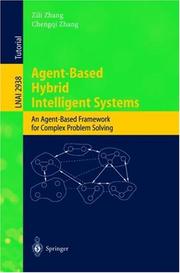
ISBN: 1280306785 9786610306787 3540246231 3540209085 Year: 2004 Publisher: Berlin, Heidelberg : Springer Berlin Heidelberg : Imprint: Springer,
Abstract | Keywords | Export | Availability | Bookmark
 Loading...
Loading...Choose an application
- Reference Manager
- EndNote
- RefWorks (Direct export to RefWorks)
Solving complex problems in real-world contexts, such as financial investment planning or mining large data collections, involves many different sub-tasks, each of which requires different techniques. To deal with such problems, a great diversity of intelligent techniques are available, including traditional techniques like expert systems approaches and soft computing techniques like fuzzy logic, neural networks, or genetic algorithms. These techniques are complementary approaches to intelligent information processing rather than competing ones, and thus better results in problem solving are achieved when these techniques are combined in hybrid intelligent systems. Multi-Agent Systems are ideally suited to model the manifold interactions among the many different components of hybrid intelligent systems. This book introduces agent-based hybrid intelligent systems and presents a framework and methodology allowing for the development of such systems for real-world applications. The authors focus on applications in financial investment planning and data mining.
Computer science. --- Software engineering. --- Database management. --- Artificial intelligence. --- Information systems. --- Computer Science. --- Artificial Intelligence (incl. Robotics). --- Software Engineering. --- Computation by Abstract Devices. --- Database Management. --- Computer Appl. in Administrative Data Processing. --- Intelligent agents (Computer software) --- Expert systems (Computer science) --- Soft computing --- Hybrid computers --- Computer Science --- Engineering & Applied Sciences --- Soft computing. --- Hybrid computers. --- Knowledge-based systems (Computer science) --- Systems, Expert (Computer science) --- Agents, Autonomous (Computer software) --- Agents, Cognitive (Computer software) --- Agents, Intelligent (Computer software) --- Assistants, Cognitive (Computer software) --- Assistants, Intelligent software --- Autonomous agents (Computer software) --- Cognitive agents (Computer software) --- Cognitive assistants (Computer software) --- IAs (Computer software) --- Intelligent agent software --- Intelligent software agents --- Intelligent software assistants --- Software agents (Computer software) --- Special agents (Computer software) --- Computers. --- Application software. --- Computers --- Cognitive computing --- Electronic data processing --- Computational intelligence --- Artificial intelligence --- Computer systems --- Computer programs --- Artificial Intelligence. --- Data base management --- Data services (Database management) --- Database management services --- DBMS (Computer science) --- Generalized data management systems --- Services, Database management --- Systems, Database management --- Systems, Generalized database management --- Informatics --- Science --- Computer software engineering --- Engineering --- AI (Artificial intelligence) --- Artificial thinking --- Electronic brains --- Intellectronics --- Intelligence, Artificial --- Intelligent machines --- Machine intelligence --- Thinking, Artificial --- Bionics --- Cognitive science --- Digital computer simulation --- Logic machines --- Machine theory --- Self-organizing systems --- Simulation methods --- Fifth generation computers --- Neural computers --- Application computer programs --- Application computer software --- Applications software --- Apps (Computer software) --- Computer software --- Automatic computers --- Automatic data processors --- Computer hardware --- Computing machines (Computers) --- Electronic calculating-machines --- Electronic computers --- Hardware, Computer --- Cybernetics --- Calculators --- Cyberspace --- Information technology --- Theory of Computation. --- Computer Application in Administrative Data Processing. --- Management.
Book
ISBN: 3319041711 331904172X Year: 2014 Publisher: Cham : Springer International Publishing : Imprint: Springer,
Abstract | Keywords | Export | Availability | Bookmark
 Loading...
Loading...Choose an application
- Reference Manager
- EndNote
- RefWorks (Direct export to RefWorks)
This book is organized into thirteen chapters that range over the relevant approaches and tools in data integration, modeling, analysis and knowledge discovery for signaling pathways. Having in mind that the book is also addressed for students, the contributors present the main results and techniques in an easily accessed and understood way together with many references and instances. Chapter 1 presents an introduction to signaling pathway, including motivations, background knowledge and relevant data mining techniques for pathway data analysis. Chapter 2 presents a variety of data sources and data analysis with respect to signaling pathway, including data integration and relevant data mining applications. Chapter 3 presents a framework to measure the inconsistency between heterogenous biological databases. A GO-based (genome ontology) strategy is proposed to associate different data sources. Chapter 4 presents identification of positive regulation of kinase pathways in terms of association rule mining. The results derived from this project could be used when predicting essential relationships and enable a comprehensive understanding of kinase pathway interaction. Chapter 5 presents graphical model-based methods to identify regulatory network of protein kinases. A framework using negative association rule mining is introduced in Chapter 6 to discover featured inhibitory regulation patterns and the relationships between involved regulation factors. It is necessary to not only detect the objects that exhibit a positive regulatory role in a kinase pathway but also to discover those objects that inhibit the regulation. Chapter 7 presents methods to model ncRNA secondary structure data in terms of stems, loops and marked labels, and illustrates how to find matched structure patterns for a given query. Chapter 8 shows an interval-based distance metric for computing the distance between conserved RNA secondary structures. Chapter 9 presents a framework to explore structural and functional patterns of RNA pseudoknot structure according to probability matrix. Chapter 10 presents methods to model miRNA data and identify miRNA interaction of cross-species and within-species. Chapter 11 presents an approach to measure the importance of miRNA site and the adjacent base by using information redundancy and develops a novel measure to identify strongly correlated infrequent itemsets. The discover association rules not only present important structural features in miRNAs, but also promote a comprehensive understanding of regulatory roles of miRNAs. Chapter 12 presents bioinformatics techniques for protein kinase data management and analysis, kinase pathways and drug targets, and describes their potential application in pharmaceutical industry. Chapter 13 presents a summary of the chapters and give a brief discussion to some emerging issues.
Computer science. --- Computer software. --- Database management. --- Information storage and retrieval systems. --- Artificial intelligence. --- Computer Science. --- Artificial Intelligence (incl. Robotics). --- Database Management. --- Algorithm Analysis and Problem Complexity. --- Information Systems Applications (incl. Internet). --- Information Storage and Retrieval. --- Computation by Abstract Devices. --- Mechanical Engineering --- Engineering & Applied Sciences --- Computer Science --- Mechanical Engineering - General --- AI (Artificial intelligence) --- Artificial thinking --- Electronic brains --- Intellectronics --- Intelligence, Artificial --- Intelligent machines --- Machine intelligence --- Thinking, Artificial --- Automatic data storage --- Automatic information retrieval --- Automation in documentation --- Computer-based information systems --- Data processing systems --- Data storage and retrieval systems --- Discovery systems, Information --- Information discovery systems --- Information processing systems --- Information retrieval systems --- Machine data storage and retrieval --- Mechanized information storage and retrieval systems --- Data base management --- Data services (Database management) --- Database management services --- DBMS (Computer science) --- Generalized data management systems --- Services, Database management --- Systems, Database management --- Systems, Generalized database management --- Software, Computer --- Informatics --- Computers. --- Algorithms. --- Information storage and retrieval. --- Bioinformatics. --- Computational biology. --- Data mining. --- Biology --- Bioinformatics --- Algorithmic knowledge discovery --- Factual data analysis --- KDD (Information retrieval) --- Knowledge discovery in data --- Knowledge discovery in databases --- Mining, Data --- Database searching --- Bio-informatics --- Biological informatics --- Information science --- Computational biology --- Systems biology --- Data processing --- Information storage and retrieva. --- Artificial Intelligence. --- Science --- Computer systems --- Electronic data processing --- Bionics --- Cognitive science --- Digital computer simulation --- Logic machines --- Machine theory --- Self-organizing systems --- Simulation methods --- Fifth generation computers --- Neural computers --- Application software. --- Automatic computers --- Automatic data processors --- Computer hardware --- Computing machines (Computers) --- Electronic calculating-machines --- Electronic computers --- Hardware, Computer --- Cybernetics --- Calculators --- Cyberspace --- Application computer programs --- Application computer software --- Applications software --- Apps (Computer software) --- Computer software --- Algorism --- Algebra --- Arithmetic --- Foundations
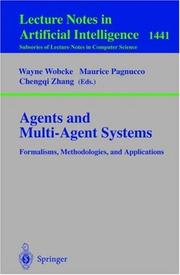
ISSN: 03029743 ISBN: 3540647694 9783540647690 354068722X Year: 1998 Volume: 1441 Publisher: Berlin, Heidelberg : Springer Berlin Heidelberg : Imprint: Springer,
Abstract | Keywords | Export | Availability | Bookmark
 Loading...
Loading...Choose an application
- Reference Manager
- EndNote
- RefWorks (Direct export to RefWorks)
This book constitutes the thoroughly refereed post-workshop proceedings of three workshops held in conjunction with the 10th Australian Joint Conference on Artificial Intelligence in Perth, Australia, in December 1997. The 17 revised full papers presented were carefully reviewed for inclusion in the book. The book is divided into sections on formal methods of agency, reasoning agents, communication and coordination, social interaction, and practical issues for distributed artificial intelligence systems.
Distributed artificial intelligence --- Intelligent agents (Computer software) --- Commonsense reasoning --- Common sense reasoning --- Computer science. --- Computer communication systems. --- Software engineering. --- Artificial intelligence. --- Computer Science. --- Artificial Intelligence (incl. Robotics). --- Computer Communication Networks. --- Software Engineering. --- AI (Artificial intelligence) --- Artificial thinking --- Electronic brains --- Intellectronics --- Intelligence, Artificial --- Intelligent machines --- Machine intelligence --- Thinking, Artificial --- Bionics --- Cognitive science --- Digital computer simulation --- Electronic data processing --- Logic machines --- Machine theory --- Self-organizing systems --- Simulation methods --- Fifth generation computers --- Neural computers --- Computer software engineering --- Engineering --- Communication systems, Computer --- Computer communication systems --- Data networks, Computer --- ECNs (Electronic communication networks) --- Electronic communication networks --- Networks, Computer --- Teleprocessing networks --- Data transmission systems --- Digital communications --- Electronic systems --- Information networks --- Telecommunication --- Cyberinfrastructure --- Network computers --- Informatics --- Science --- Distributed processing --- Congresses --- Artificial Intelligence. --- Distributed artificial intelligence - Congresses --- Intelligent agents (Computer software) - Congresses --- Commonsense reasoning - Congresses
Digital
ISBN: 9783319041728 Year: 2014 Publisher: Cham Springer International Publishing
Abstract | Keywords | Export | Availability | Bookmark
 Loading...
Loading...Choose an application
- Reference Manager
- EndNote
- RefWorks (Direct export to RefWorks)
This book is organized into thirteen chapters that range over the relevant approaches and tools in data integration, modeling, analysis and knowledge discovery for signaling pathways. Having in mind that the book is also addressed for students, the contributors present the main results and techniques in an easily accessed and understood way together with many references and instances. Chapter 1 presents an introduction to signaling pathway, including motivations, background knowledge and relevant data mining techniques for pathway data analysis. Chapter 2 presents a variety of data sources and data analysis with respect to signaling pathway, including data integration and relevant data mining applications. Chapter 3 presents a framework to measure the inconsistency between heterogenous biological databases. A GO-based (genome ontology) strategy is proposed to associate different data sources. Chapter 4 presents identification of positive regulation of kinase pathways in terms of association rule mining. The results derived from this project could be used when predicting essential relationships and enable a comprehensive understanding of kinase pathway interaction. Chapter 5 presents graphical model-based methods to identify regulatory network of protein kinases. A framework using negative association rule mining is introduced in Chapter 6 to discover featured inhibitory regulation patterns and the relationships between involved regulation factors. It is necessary to not only detect the objects that exhibit a positive regulatory role in a kinase pathway but also to discover those objects that inhibit the regulation. Chapter 7 presents methods to model ncRNA secondary structure data in terms of stems, loops and marked labels, and illustrates how to find matched structure patterns for a given query. Chapter 8 shows an interval-based distance metric for computing the distance between conserved RNA secondary structures. Chapter 9 presents a framework to explore structural and functional patterns of RNA pseudoknot structure according to probability matrix. Chapter 10 presents methods to model miRNA data and identify miRNA interaction of cross-species and within-species. Chapter 11 presents an approach to measure the importance of miRNA site and the adjacent base by using information redundancy and develops a novel measure to identify strongly correlated infrequent itemsets. The discover association rules not only present important structural features in miRNAs, but also promote a comprehensive understanding of regulatory roles of miRNAs. Chapter 12 presents bioinformatics techniques for protein kinase data management and analysis, kinase pathways and drug targets, and describes their potential application in pharmaceutical industry. Chapter 13 presents a summary of the chapters and give a brief discussion to some emerging issues.
Information retrieval --- Complex analysis --- Computer science --- Computer architecture. Operating systems --- Information systems --- Artificial intelligence. Robotics. Simulation. Graphics --- Computer. Automation --- IR (information retrieval) --- complexe analyse (wiskunde) --- bio-informatica --- bedrijfssoftware --- computers --- informatica --- informatiesystemen --- database management --- KI (kunstmatige intelligentie) --- computerkunde --- robots
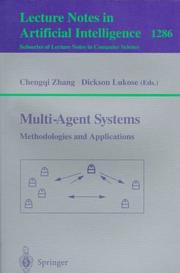
ISBN: 3540634126 3540695400 9783540634126 Year: 1997 Volume: 1286 Publisher: Berlin, Heidelberg : Springer Berlin Heidelberg : Imprint: Springer,
Abstract | Keywords | Export | Availability | Bookmark
 Loading...
Loading...Choose an application
- Reference Manager
- EndNote
- RefWorks (Direct export to RefWorks)
This book constitutes the strictly refereed post-workshop proceedings originating from the Second Australian Workshop on Distributed Artificial Intelligence, held in Cairns, QLD, Australia, in August 1996, as a satellite meeting of PRICAI'96. The 13 revised full papers presented have been selected for inclusion in the book during a very careful and iterated process of reviewing and improvement. Among these papers are three invited ones, by leading scientists, solicited in order to round off the overall presentation and coverage of relevant topics. A wide range of multi-agent systems issues is covered including methodologies, cooperation, conflict resolution, applications, mobility, adaptation, negotiation, and implementations.
Electronic data processing --- Distributed artificial intelligence --- Distributed processing --- Congresses. --- Computer Science --- Engineering & Applied Sciences --- Congresses --- ADP (Data processing) --- Automatic data processing --- Data processing --- EDP (Data processing) --- IDP (Data processing) --- Integrated data processing --- Computer science. --- Artificial intelligence. --- Computer Science. --- Artificial Intelligence (incl. Robotics). --- Artificial Intelligence. --- AI (Artificial intelligence) --- Artificial thinking --- Electronic brains --- Intellectronics --- Intelligence, Artificial --- Intelligent machines --- Machine intelligence --- Thinking, Artificial --- Bionics --- Cognitive science --- Digital computer simulation --- Logic machines --- Machine theory --- Self-organizing systems --- Simulation methods --- Fifth generation computers --- Neural computers --- Electronic data processing - Distributed processing - Congresses. --- Distributed artificial intelligence - Congresses.
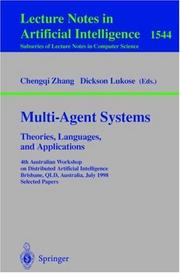
ISBN: 3540654771 3540492410 9783540654773 Year: 1998 Volume: 1544 Publisher: Berlin ; Heidelberg : Springer,
Abstract | Keywords | Export | Availability | Bookmark
 Loading...
Loading...Choose an application
- Reference Manager
- EndNote
- RefWorks (Direct export to RefWorks)
Intelligent agents (Computer software) --- Electronic data processing --- Distributed artificial intelligence --- Congresses --- Distributed processing --- Computer Science --- Engineering & Applied Sciences --- Computer science. --- Software engineering. --- Artificial intelligence. --- Computer Science. --- Software Engineering/Programming and Operating Systems. --- Artificial Intelligence (incl. Robotics). --- Intelligent agents (Computer science) --- Artificial Intelligence. --- AI (Artificial intelligence) --- Artificial thinking --- Electronic brains --- Intellectronics --- Intelligence, Artificial --- Intelligent machines --- Machine intelligence --- Thinking, Artificial --- Bionics --- Cognitive science --- Digital computer simulation --- Logic machines --- Machine theory --- Self-organizing systems --- Simulation methods --- Fifth generation computers --- Neural computers --- Computer software engineering --- Engineering --- Computer science --- Artificial intelligence --- Intelligent agents (Computer software) - Congresses --- Electronic data processing - Distributed processing - Congresses --- Distributed artificial intelligence - Congresses
Book
ISBN: 1489985077 1441957367 9786612835841 1441957375 128283584X Year: 2010 Publisher: New York : Springer Science,
Abstract | Keywords | Export | Availability | Bookmark
 Loading...
Loading...Choose an application
- Reference Manager
- EndNote
- RefWorks (Direct export to RefWorks)
In the present thriving global economy a need has evolved for complex data analysis to enhance an organization’s production systems, decision-making tactics, and performance. In turn, data mining has emerged as one of the most active areas in information technologies. Domain Driven Data Mining offers state-of the-art research and development outcomes on methodologies, techniques, approaches and successful applications in domain driven, actionable knowledge discovery. About this book: Enhances the actionability and wider deployment of existing data-centered data mining through a combination of domain and business oriented factors, constraints and intelligence. Examines real-world challenges to and complexities of the current KDD methodologies and techniques. Details a paradigm shift from "data-centered pattern mining" to "domain driven actionable knowledge discovery" for next-generation KDD research and applications. Bridges the gap between business expectations and research output through detailed exploration of the findings, thoughts and lessons learned in conducting several large-scale, real-world data mining business applications Includes techniques, methodologies and case studies in real-life enterprise data mining Addresses new areas such as blog mining Domain Driven Data Mining is suitable for researchers, practitioners and university students in the areas of data mining and knowledge discovery, knowledge engineering, human-computer interaction, artificial intelligence, intelligent information processing, decision support systems, knowledge management, and KDD project management.
Artificial intelligence -- Congresses. --- Computer graphics -- Congresses. --- Data mining --- Business --- Commerce --- Engineering & Applied Sciences --- Marketing & Sales --- Computer Science --- Business & Economics --- Data processing --- Data mining. --- Data processing. --- Trade --- Algorithmic knowledge discovery --- Factual data analysis --- KDD (Information retrieval) --- Knowledge discovery in data --- Knowledge discovery in databases --- Mining, Data --- Computer science. --- Information technology. --- Business mathematics. --- Information storage and retrieval. --- Computer Science. --- Data Mining and Knowledge Discovery. --- Information Storage and Retrieval. --- Business Mathematics. --- IT in Business. --- Information Systems Applications (incl. Internet). --- Database searching --- Arithmetic, Commercial --- Business arithmetic --- Business math --- Commercial arithmetic --- Finance --- Mathematics --- Electronic data processing --- IT (Information technology) --- Technology --- Telematics --- Information superhighway --- Knowledge management --- Informatics --- Science --- Economics --- Transportation --- Information storage and retrieva. --- Information storage and retrieval systems. --- Automatic data storage --- Automatic information retrieval --- Automation in documentation --- Computer-based information systems --- Data processing systems --- Data storage and retrieval systems --- Discovery systems, Information --- Information discovery systems --- Information processing systems --- Information retrieval systems --- Machine data storage and retrieval --- Mechanized information storage and retrieval systems --- Computer systems --- Electronic information resources --- Data libraries --- Digital libraries --- Information organization --- Information retrieval --- Business—Data processing. --- Application software. --- Application computer programs --- Application computer software --- Applications software --- Apps (Computer software) --- Computer software
Book
ISBN: 9783540850748 Year: 2008 Publisher: Berlin Heidelberg Springer Berlin Heidelberg
Abstract | Keywords | Export | Availability | Bookmark
 Loading...
Loading...Choose an application
- Reference Manager
- EndNote
- RefWorks (Direct export to RefWorks)
The present volume arose from the need for a comprehensive coverage of the state of the art in security protocol analysis. It aims to serve as an overall course-aid and to provide self-study material for researchers and students in formal methods theory and applications in e-commerce, data analysis and data mining. The volume will also be useful to anyone interested in secure e-commerce. The book is organized in eight chapters covering the main approaches and tools in formal methods for security protocol analysis. It starts with an introductory chapter presenting the fundamentals and background knowledge with respect to formal methods and security protocol analysis. Chapter 2 provides an overview of related work in this area, including basic concepts and terminology. Chapters 3 and 4 show a logical framework and a model checker for analyzing secure transaction protocols. Chapter 5 explains how to deal with uncertainty issues in secure messages, including inconsistent messages and conflicting beliefs in messages. Chapter 6 integrates data mining with security protocol analysis, and Chapter 7 develops a new technique for detecting collusion attack in security protocols. Chapter 8 gives a summary of the chapters and presents a brief discussion of some emerging issues in the field.
| Listing 1 - 10 of 22 | << page >> |
Sort by
|

 Search
Search Feedback
Feedback About UniCat
About UniCat  Help
Help News
News